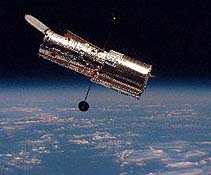(29a) Spacecraft Observing the Sun and the Heavens above
The Earth's atmosphere, while transparent to visible light, absorbs most "electromagnetic radiations" which belong to the same family as light: parts of the infra-red (IR) and all of the ultra-violet (UV), X-rays and gamma rays. And even in visible light, atmospheric fluctuations (similar to the ones that cause stars to twinkle in the summertime) blur telescope images taken at high magnification. The Hubble telescope, in low Earth orbit, overcomes such limitations, in the visible range and in part of the UV. In a celebrated recent time exposure, Hubble remained locked on the same patch of the northern sky for 10 days, returning a sharp image of objects much too faint to be seen otherwise, most of them very distant galaxies. So fruitful was this observation that a second "deep field" exposure of such length, near the southern pole of the heavens, was recently conducted. It yielded a comparably rich array of distant objects. NASA now plans a "next generation space telescope" (NGST) to be placed at the Lagrangian L2 point. In the UV Hubble was preceded by the US-Dutch "International UV Explorer" (IUV), a telescope in synchronous orbit used remotely by astronomers around the globe, like a ground-based observatory. The Infra-Red Astronomy Satellite (IRAS) observed the sky in infra-red and was particularly impressive in its study of the "cosmic background" radiation, left from the "big bang" in which the universe (apparently) began. IRAS was cooled by a well-insulated container of liquid helium, which last months. Several X-ray observatories have surveyed and studied X-ray sources in the sky, most recently the European "Rosat" (Roentgen Satellite) named for the man who discovered X-rays one century before its launch. A large Advanced X-Ray Astrophysics Facility (AXAF) has been renamed Chandra, the nickname of the late distinguished astronomer Subrahmanyan Chandrasekhar. It is due to be launched by NASA in May 1999, the original January launch delayed by a circuit board overhaul. Another European observatory, Beppo SAX (named after the physicist Giuseppe "Beppo" Ochialini) has helped pin-point the first visible source of X-ray and gamma ray bursts. The Compton Gamma Ray Observatory observed the start of that event and also provided evidence showing that the sources of these bursts are very distant and they therefore should represent incredibly large and sudden energy-release events in the early universe. Some satellites specialize in observing the Sun, such as the Japanese Yohkoh and NASA's SOHO. Yohkoh obtained striking images of the Sun in X-rays, while SOHO observes subtle oscillations of the entire Sun, "sunquakes" which tell about the Sun's unseen interior. It also observed "coronal mass ejections" headed for Earth, eruptions whose arrival a few days later may bring a magnetic storm. |



